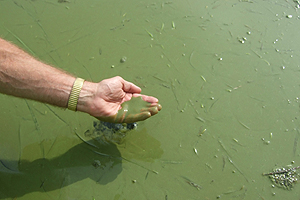Toledo Law researchers outline legal tools for battling harmful algal blooms in Lake Erie
April 29, 2012
 |
Researchers from The University of Toledo College of Law are contributing to the battle against harmful algal blooms in Lake Erie with their new white paper, “Legal Tools for Reducing Harmful Algal Blooms in Lake Erie.”
Harmful algal blooms (HABs), excessive growths of toxin-producing cyanobacteria, have reached crisis proportions in recent summers in Lake Erie. Triggered primarily by excess phosphorus, HABs cause economic and ecological harm and threaten public health.
The white paper, co-authored by Kenneth Kilbert, associate professor at Toledo Law and director of its Legal Institute of the Great Lakes, M. Zack Hohl ’12 and Tiffany Tisler ’11, highlights the legal tools currently available for controlling key sources of phosphorus in Ohio by describing the complex web of federal and state laws. Additionally, the paper makes recommendations for using these existing tools and for changing the law in Ohio to help reduce the formation of HABs in Lake Erie.
The federal Clean Water Act, supplemented by state law, has been relatively successful in reducing phosphorus pollution from point sources in Ohio, although there is still room for improvement. By contrast, nonpoint sources are virtually unregulated by federal law, and Ohio law only partially fills the regulatory gap.
Recommendations set forth in the white paper include:
- Promulgate numeric water quality criteria for phosphorus.
- Designate the Lake Erie watershed “in distress,” triggering more nutrient controls.
- Establish minimum best management practices applicable to all farming operations and streamline enforcement of them.
- Broaden the statutory definition of “concentrated animal feeding facility” to include more animal feeding operations.
- Establish more stringent phosphorus effluent limits for publicly owned treatment works.
- Require more NPDES permit holders to monitor for phosphorus.
- More aggressively enforce against home sewage treatment systems that contribute significantly to phosphorus pollution.
- Encourage water quality trading.
- Enact legislation restricting the application of phosphorus-containing fertilizer on lawns.
- Prioritize grant funding for projects that reduce phosphorus loading.
The paper is part of a multi-disciplinary research and public outreach project partially
funded by a grant from the National Sea Grant Law Center. The project also included
two workshops earlier this year in Toledo and Columbus featuring experts from science,
government and law addressing best practices and legal tools for reducing HABs in
Lake Erie.
Workshop materials and other information about HABs and Lake Erie also are available
at http://www.utoledo.edu/law/academics/ligl/habs-workshops.html.


